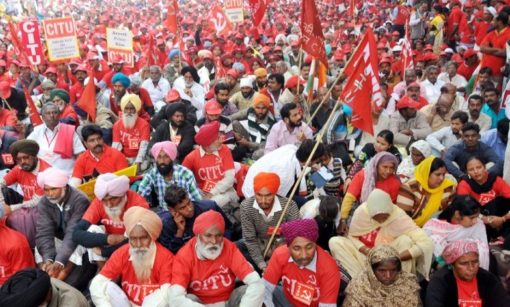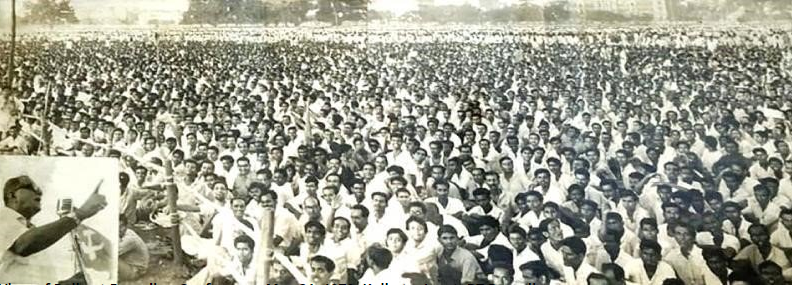
On May 28-30, 1970, trade union activists from 18 states representing 1,759 trade unions assembled in Kolkata for a conference. The atmosphere was electric, recall those who attended. The country was in ferment with industrial strikes bursting out here and there, as were the repeated clashes between fighting workers and police or strike-breaking goon squads. Within the trade unions too, there was tension – between those who wanted to press forth with class struggles and those who wanted restraint, having hopes in conciliation and government mediation. These expectations and tensions were what brought energy to the gathering in Kolkata’s Ranji Stadium, renamed Lenin Nagar for the occasion.
The conference started successfully with all the delegates unanimous in taking a momentous decision – to leave the existing All India Trade Union Congress (AITUC) and form a separate organisation called the Centre of Indian Trade Unions (CITU). The resolution to this effect was passed with thunderous applause. Earlier, a report on the activities and events leading to the decision, moved by well-known trade unionist P. Ramamurti and circulated in English, Hindi, Bengali, Urdu, Tamil and Malayalam, was also adopted. The main message: the class collaborationist trend in trade unions was to be fought back and there was no option for the revolutionary sections but to part ways and strike a new path based on class struggle.
Later, on May 31, 1970, a gigantic and enthusiastic rally was held at Brigade Parade Grounds, reportedly attended by 10 lakh people. A galaxy of trade union leaders, including the likes of Jyoti Basu, E. Balanandan, Ramamurti and the newly elected president of CITU, BT Ranadive, were amongst the speakers.

Legacy of 50 years
How has this militant stream of India’s fragmented trade union movement fared in half a century since its formation? At the time of the first conference in Kolkata, the membership was just over 8 lakh. Currently, it stands at over 60 lakh. About two thirds of this is made up of unorganised sector workers, contrary to the lies propagated by industrialists and media that trade unions only work for the organised sector employees. Also, about one third of CITU’s membership is women.
The CITU has acquired and maintained a reputation of honesty and militant struggles. Right after its formation, and despite facing unparalleled attack in West Bengal in the early 1970s during the semi-fascist terror unleashed by the then Congress state government, CITU actively got involved in the heroic railway strike of 1974 which lasted for 20 days. The railways had different trade unions working amongst the employees and so, a National Coordination Committee for Railwaymen’s Struggles (NCCRS) was formed of which CITU became an important part. Only the Congress-led Indian National Trade Union Congress (INTUC) kept out of this joint committee. CITU also organised solidarity actions, legal aid and all other forms of relief and support for the victimised workers.
During the Emergency (1975-77) declared by the Indira Gandhi-led Congress government, CITU continued to brave repression and arrests of activists. It fought against the open attack on workers’ rights which included prohibition of strikes and other protests, banning of bonus payments, freeze on wages and a wave of retrenchments by aggressive industrialists. With these activities, CITU established itself as clearly different from various collaborationist unions who buried their heads in the sand in this grave period of attack on the working class.
After the Emergency was lifted and a process of re-establishing democracy started under the new government, CITU emerged in the forefront of struggles when it took the initiative of forming a joint platform with other trade unions to fight back a new draconian Industrial Relations Bill in 1978. Such was the scale of protests across the country that it had to be withdrawn by the Morarji Desai-led Janata Party government.
In 1982, the CITU again took the initiative of building a joint platform with other trade unions to call for and successfully organise the first all India strike of workers on January 19. Through this strike the working class also raised demands of farmers and agricultural workers drawing their active participation in various parts of the country. Such was the sweep of angry protests during the strike and an equally repressive reaction by the government that ten workers, including agricultural workers, died in police firing in various parts of the country on that day.
Besides these massive all India actions, CITU-led federations in various sectors like coal, port and dock, steel, plantations, etc. conducted strike struggles for better wages and better working conditions.
Since the early 1990s, when economic liberalisation and globalisation was imposed on the country, the CITU has played the leading role in uniting various trade union bodies and adopting the path of militant struggles. Altogether 18 countrywide general strikes were held under the leadership of the joint trade union movement, the latest being the historic strike on January 8-9, 2019, in which around 20 crore workers participated and which received wide support of the common people.
Most Advanced Section of Working Class Movement
Not only because of its commitment to class struggle, but CITU’s pre-eminent position has also emerged because it usually provides the best, most meticulous and detailed critique of ongoing developments domestically, as well as internationally. For instance, the trade union movement looks to CITU for providing the detailed analysis of Modi government’s proposed merger of labour laws and their reforms, which turned out to be nothing but an attempt to completely dilute the laws and make them employer friendly. Similarly, on sectoral policies – pharmaceutical or telecom or steel or banking and insurance, etc. – CITU has the wherewithal to incisively analyse and provide the necessary material for equipping the trade union movement for its struggles.
New Sections Drawn into Struggle
Besides the emphasis on struggles, one of the distinguishing features of CITU’s work has been in its ability to draw in new sections of workers which were either not unionised or may even have emerged in recent decades. A good example of this is the phenomenal expansion of CITU’s influence among the so-called scheme workers, that is, workers in various government-run schemes. There are an estimated one crore such workers in India, mostly women, who are contractual, get measly wages, are not recognised as regular workers and yet are devoted to delivering essential services like healthcare, child care, education, etc. Through its federations of Anganwadi workers and helpers, mid-day meal workers, and Accredited Social Health Activist (ASHA) workers’ unions, CITU has organised and led lakhs of these workers in struggles and achieved significant victories over the years.
With the growth of contractualisation as an employers’ strategy to reduce wage bills and enslave workers, CITU has also made efforts to draw in contract workers into organisation and struggles in various important sectors like steel, transport, construction, plantation and among the general Micro, Small and Medium Enterprises (MSME) units across the country. This is a difficult task given the instability of these sectors and particularly, these type of employment relations.
Stress On Unity
Although the working class is highly divided among various trade unions which are patronised by political parties, CITU has also successfully built united struggle platforms through the years with unions of all shades and hues. Mostly, unions affiliated with big political parties become inactive in periods when their party is in power, like the Rashtriya Swayamsevak Sangh affiliated Bharatiya Mazdoor Sangh currently, and they opt out. But most strike actions in recent decades have been joint calls. This means that the reach and experience of struggles is far beyond the CITU’s organisational influence.
In the coming days, a wider variety of issues will need to be confronted and tackled by the trade union movement – unemployment, communal and casteist divisions, jingoist influences, and so on. The divisive issues invariably lead to calls for a collaborationist approach, disarming the trade union movement. Unemployment strikes at workers’ rights through depression of wages and blatant hiring and firing, again disarming the movement. While CITU has been addressing these issues, it will have to show the way for the rest of the movement too, like it has done in other things.




